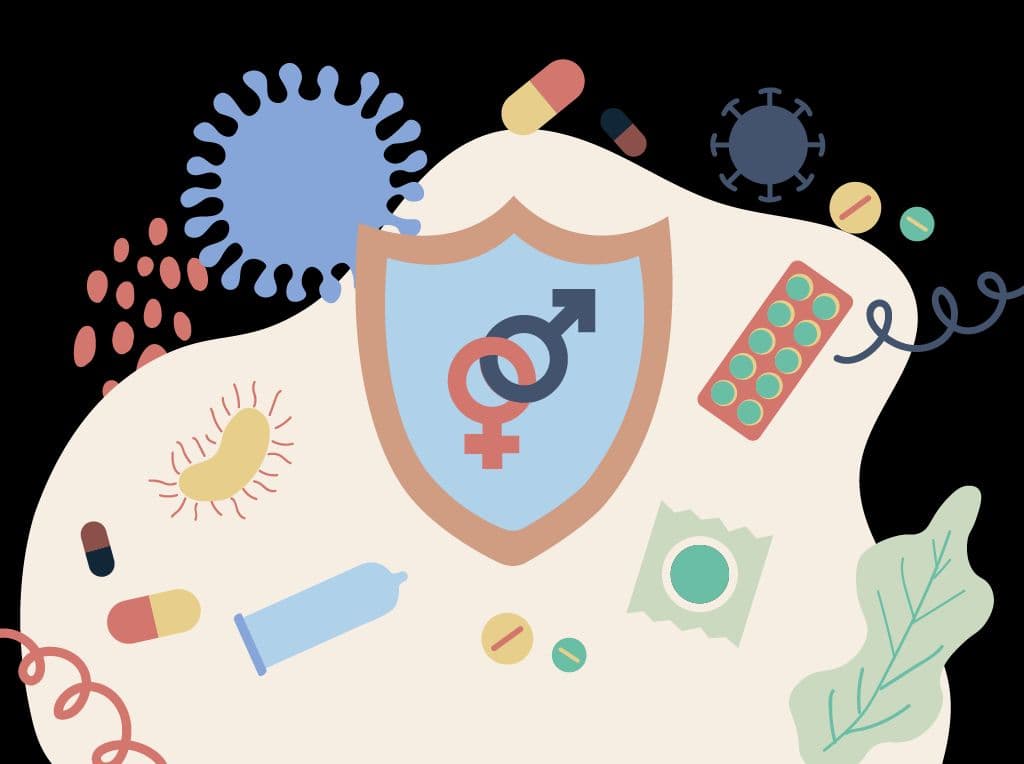A friend of mine was in a relationship where her partner at the time deplored the use of condoms as they ‘dulled any sensation’ for him. To find a solution, they both got themselves tested to ensure they were free of sexually transmitted infections (nice and responsible), and she switched to taking oral contraceptive (OC) pills. She, however, experienced tenderness and pain in her breasts. I referred her to my doctor who recommended taking a break from the pills and prescribed Primrose oil (with Gamma Linolenic acid) and Vitamin E. It took around five months for the pain to disappear. They switched back to condoms and surprise, surprise – there weren’t any issues.
Analysis: Health always comes first. Pleasure can come second. But do we as women, take our sexual health seriously enough to always follow this sequence?
In my friend’s case, her partner was understanding and cared about her health. But this may not always be the case. And that’s when it is up to us to put ourselves first.
In any case, this incident piqued my interest in contraceptives. What are all the options that exist out there? What are the pros and cons? Even though I thought of myself as reasonably well informed on this topic, perhaps there was something out there I didn’t know about that would suit me better personally? So today, I would like to share with you a 3600 view of contraception in the hope that it might provide useful and relevant information. We’ll go a mile wide and an inch deep.
Contraceptives are prophylactics, i.e. preventative measures in the form of medication or a device to prevent pregnancy. Some are prophylactic against sexually transmitted infections as well but not all. The term ‘Contraceptive’ basically means ‘against’ (contra) conception. Lexico.com defines it as “the deliberate use of artificial methods or other techniques to prevent pregnancy as a consequence of sexual intercourse.” While other techniques include the withdrawal method and abstinence, we will focus on artificial methods in this article.

Hormone Based Contraceptives
The artificial hormones progestins and estrogens form the basis of hormonal contraceptive techniques. A progestin is a man-made progestogen, which is a type of medication which produces effects similar to those of the natural female sex hormone progesterone in the body. The same applies to synthetically produced estrogens and the natural estrogens in the female body namely estrone, estradiol, and estriol.
Hormonal therapy prevents pregnancy in three ways: 1) by preventing the release of eggs from the ovaries (ovulation) 2) by thickening the cervical mucus making it hard for sperm to travel to reach the egg and 3) by thinning the lining of the uterus and thereby preventing the implantation of the fertilized egg.
1.Birth Control Pills:
This is the most common and inexpensive method of hormonal contraception. Combination pills contain both progestin and estrogen while mini pills contain only progestin.
An example of a combination pill available in India is Crisanta which contains Drospirenone 3mg (progestin) + Ethinyl Estradiol 0.03 mg (estrogen) in each tablet.
An example of a progestin only pill (POP) available in India is Cerazette in which each tablet contains 75 microgram Desogestrel. POPs must be taken in a specific three hour window each day to ensure efficiency.
Generally, combination pills come in 21 or 24 day strips while mini pills come in 28 day strips, with one pill taken daily.
It is important to note that there are hundreds of birth control pills of both types on the market and it is imperative to discuss with your doctor what is most suitable for you taking into account any allergies, sensitivity, underlying medical conditions or long-standing medications being consumed.
Some pills may have other beneficial effects such as clearing acne or assisting with hirsutism. Common side effects such as irregular bleeding, breast tenderness and nausea may occur but many women’s bodies apparently adjust to this over time. It is however important to keep your doctor apprised of any side effects so that your condition is monitored and decisive action can be taken if side effects persist. Serious side effects such as spontaneous blot clots, deep vein thrombosis, heart attacks, strokes and high blood pressure may also occur although these are rare and it is important to be aware of the side effects of any medication you are taking.
Women who smoke and are over the age of 35 are especially at risk of adverse effects due to any type of hormonal contraception. Similarly, some contraception may not be as effective in women who are overweight. This has to be confirmed with your doctor. The availability of certain birth control pills over the counter in certain pharmacies in India does NOT mean that the advice of a doctor is replaceable with information off the internet.
2.Birth Control Patch
The birth control patch contains a combination of estrogen and progestin, and is easily applied to the skin (of the back, stomach, buttocks or upper arm but not on the breasts) and left in place for a week. A new patch is worn every week for three weeks, then no patch is worn for the fourth week when you can have your period. Other than the usual side effects of hormonal contraception, skin irritation may also occur. Currently, patches of brands such as Evra, Twirla and Xulane are difficult to obtain if not unavailable in India.
3. Vaginal Ring
The vaginal ring is an alternative method of hormonal contraception and it increases compliance while ensuring you don’t have to worry about forgetting to take a pill. This is because the ring is inserted into the vagina and it stays there for three weeks. You take it out for the fourth week when you have your period.
The ring is small and flexible and made from a non-biodegradable material that releases 0.120 mg of etonogestrel (progestin) and 0.015 mg of ethinyl estradiol (estrogen) per day. The ring is mostly known by NuvaRing, its brand name. It has been available in India since 2011 and many doctors in metropolitan areas are prescribing it due to its ease of use and convenience. The use of tampons does not make Nuvaring less effective. During sexual intercourse, some partners may feel NuvaRing in the vagina.
Annovera, a new vaginal ring designed to be used for a whole year – was approved by the US FDA in 2018 with the company TherapeuticsMD doing test launches in late 2019. Users still wear Annovera for 21 days and remove it for 7 days each cycle, but unlike NuvaRing (where the worn ring is tossed into the trash), Annovera users can wash and store their device and use it post menstruation again, for a whole year. It uses a new form of progestin namely segesterone acetate combined with ethinyl estradiol which has been shown to inhibit ovulation for an entire year.
It is again important to be aware of side effects which include vaginal discomfort/irritation, nausea, vomiting, migraines, bloating, breast tenderness, swelling of the ankles/feet (fluid retention), irregular bleeding (spotting). Weight change may occur. Serious side effects may also occur.
4. Birth Control Shot (Depo-Provera)
Doctors can administer a progestin-only injection called Depo-Provera that protects against pregnancy for three months. After 12 weeks, the shot needs to be taken again. Common side effects of Depo-Provera include irregular bleeding, breast tenderness, change in appetite or weight gain, depression, irregular spotting, hair loss or increased hair on face or body, headache, nausea etc. Sometimes it can also lead to having no periods which may lead to false alarms that a woman is pregnant so it is important to be aware of these facts. Extended use of Depo Provera has been linked to an increased risk of osteoporosis through loss of bone mineral density in women so speak to your doctor before usage.
5. Birth Control Implant
The implant is a thin, matchstick-sized rod implanted under the skin of the woman’s upper arm using local anesthesia. The implant contains progestin only which is released over 3 years. Removal of the implant requires a small surgical procedure. Side effects may include irregular bleeding for the first 6-12 months however or it may cause longer, heavier periods. It is also 99.99% effective, i.e. the rate of failure of an implant is 0.01%. Examples include Implanon & Nexplanon.
6. Emergency Contraception (Morning after Pills)
For this topic, I have to stray from a factual tone to say first and foremost, morning after pills are for emergencies only! That means that another form of contraception has failed such as a condom tearing or a diaphragm moving out of place. This should not be a green signal for unprotected sex because these pills contain very high doses of progestins (much higher than the usual hormonal contraception) which can have serious side effects if taken frequently. Emergency contraception does not replace regular contraception and you should not reach out to them just because one of you has been too lazy to obtain sufficient condoms. Nor is it alright if your partner is unwilling to wear condoms and insisting on emergency contraception as a ‘suitable’ alternative means of contraception. It is not.
Emergency pills contain a high dose of a progestin (often Levonorgestrel 1.5 mg) and are usually available as single tablets to be taken within 72 hours of unprotected sex or failure of conventional contraceptive methods. The sooner you take them, the higher their effectiveness is. In some countries like Thailand, you may obtain a 2-tablet progestin morning after pill. These tablets are 0.75 mg each and are equally effective whether taken together or separately with a 12-hour interval. If you are not familiar with this kind of dosage, it may get confusing if the pharmacist tells you to take the pills together or separately implying that it’s your choice! Don’t worry, either way works.
Of course, it makes sense to be prepared in advance and keep emergency pills at hand so that you can take it at once if required.
Points to note-
Using any of the above hormonal methods of contraception will not stop an existing pregnancy or protect you or your partner against sexually transmitted diseases such as HIV, gonorrhea, chlamydia, syphilis etc.
Choosing a birth control method can be a difficult decision. But it’s not a decision you have to make alone. My invitation to you is to be as well informed as possible and give your sexual health the time, respect and consideration it deserves. The hormonal contraception methods discussed here all have their pros and cons, and it is for you to ask your doctor to lay out all your options for you before making your choice. Take into account side effects, allergies, weight restrictions, lifestyle choices like smoking, age, previous and current medication interactions and personal preferences. Regular follow-ups are also critical in avoiding future complications. For women who are thinking about having kids someday, it is a good idea to get information on how quickly fertility returns after discontinuing their long term contraceptive.
Disclaimer : This information is educational and should not be construed as medical advice. Please consult your doctor before making any dietary changes or adding supplements.
ProactiveForHer is a digital clinic for women, offering accessible, personalised, and confidential healthcare solutions. We offer out-patient care, diagnostic services and programs for various health concerns of Indian women, across their lifetime - from puberty to pregnancy to menopause.

